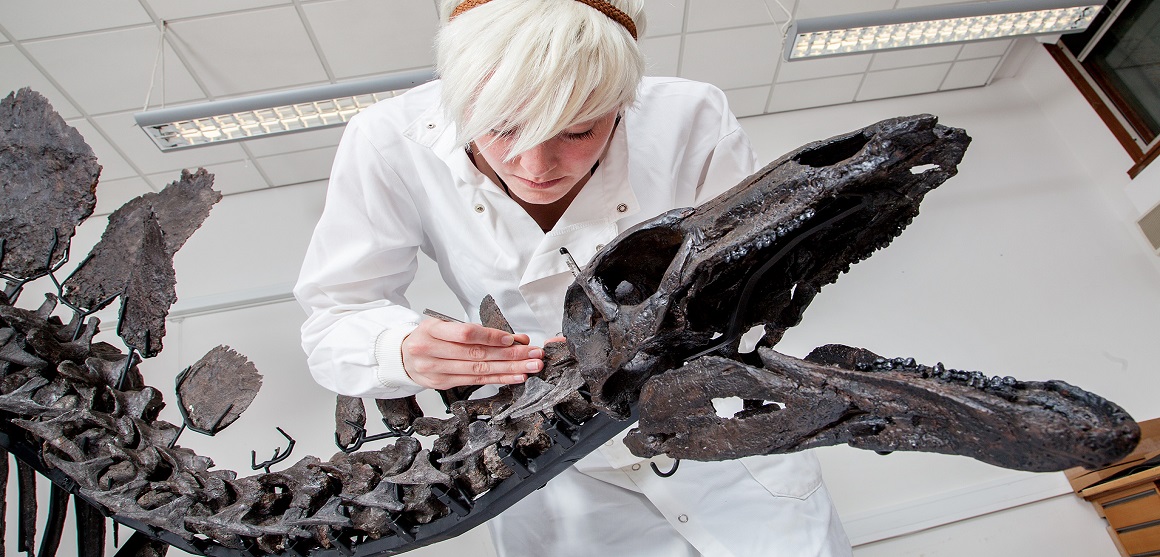Meet the first complete dinosaur specimen to go on display at the Natural History Museum in nearly 100 years.

The 150 million year old Stegosaurus stenops is the most significant dinosaur the Museum has acquired since the 1980s and the only Stegosaurus in a public collection outside the USA. It will take pride of place inside the Museum’s Exhibition Road entrance from 4 December 2014.
At 560 centimetres long and 290 centimetres tall, similar in size to a 4x4 vehicle, the skeleton has over 300 bones. It was found virtually complete in the USA 11 years ago, with only the left arm and base of the tail missing.
Professor Paul Barrett, lead dinosaur researcher at the Museum says, “It’s an honour to have this extraordinary specimen permanently on display to inspire Natural History Museum visitors. Stegosaurus fossil finds are rare. Having the world’s most complete example here for research means we can begin to uncover the secrets behind the evolution and behaviour of this intriguing dinosaur species.”
“We are extremely grateful to the 70 generous donors, with particular thanks to Jeremy Herrmann, who made this iconic acquisition possible” says Sir Michael Dixon, Director of the Natural History Museum. The specimen has been named in honour of Jeremy’s daughter Sophie Herrmann. Sir Michael adds “It inspires genuine wonder when you see it, but unlike our much-loved Diplodocus cast, this is the real thing. We hope that this amazing specimen will inspire a new generation of young visitors to learn more about the natural world and our place within it.”
There are a total of 19 plates on the back and four spikes on the tail, the most complete set ever discovered. All of the individual skull bones are three dimensional and detached from each other, making it one of the most scientifically valuable dinosaur skulls ever found. This means scientists can study the skull as never before, by closely examining individual fossils to determine eating habits and bite strength.
The sex is not known, but the animal was a young adult when it died. It was discovered in spring 2003 at the Red Canyon Ranch in Wyoming, USA by Bob Simon, who runs a dinosaur quarry on the ranch. Bob found the nearly fully connected stegosaur skeleton buried at the top of a hill while expanding the quarry. It took three weeks of excavation to bring the remarkable discovery to light.
Since its arrival at the Museum in December 2013, from private facilities in Switzerland and the USA, scientists have been taking measurements, photographs, laser surface scans and CT scans of the skeleton to find out more about the unusual lives of stegosaurs. This data will underpin a series of scientific studies.
The new acquisition becomes part of the Museum’s collection of 80 million specimens, of which eight million are fossils. The world-renowned collection is actively used by 300 Museum scientists as well as 9,000 visiting researchers from around the world every year, and inspires millions of visitors to connect with our natural world, and consider its past, present and future.
Notes for editors
Relevant images for this release can be downloaded.
- The Natural History Museum welcomes over five million visitors a year and is also a world-leading scientific research centre.
- We use our unique collection and unrivalled expertise to tackle the biggest challenges facing the world today.
- We are leaders in the scientific understanding of the origin of our planet, life on it and can predict the impact of future environmental change.
- We inspire people to engage with science to solve major societal challenges.
Contact
Weekdays: +44 (0)20 7942 5654
Evenings and weekends:
+44 (0)7799 690 151
Email: press@nhm.ac.uk